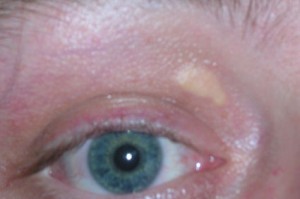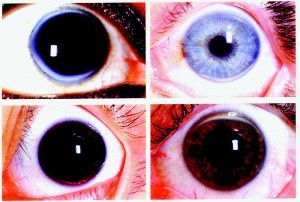Cholesterol Deposits On, Under, Around Eyes, Eyelids, Pictures
Xanthelasma and corneal arcus are two signs of elevated blood cholesterol that may be evident on the eye or eyelids. While it is not present in every case of hypercholesterolemia (elevated cholesterol) or hyperlipidemia (elevated lipids- triglycerides + cholesterol), the presence of xanthelasma or a corneal arcus should warrant further investigation for alterations of the blood lipids. There are other disorders of the blood lipids that may cause xanthelasma or corneal arcus. Similarly, these signs may be seen in a person without any disorder of the blood lipids.
Overall these eye and eyelid signs are not common in hypercholesterolemia and hyperlipidemia. In addition, it does not cause any discomfort or affect the functioning of the eye and eyelids. It is more often an aesthetic issue (cosmetic) among patients.
Elevated levels of cholesterol may not cause any overt signs or symptoms for a long period of time. However, hypercholesterolemia may arise secondary to other disorders. In this instance, xanthelasmas or corneal arcus in a patient with the following conditions should raise the concern of secondary hypercholesterolemia :
- Hypothyroidism
- Pregnancy
- Cholestatic liver disease (refer to causes of cholestatic jaundice)
- Anorexia nervosa
- Hyperparathyroidism
- Nephrotic syndrome
- Prescription drugs like corticosteroids, cyclosporin and diuretics
- Type 2 diabetes
- Central obesity
Both xanthelasma and corneal arcus are non-specific signs, especially in the elderly, but should raise concerns about hypercholesterolemia in younger age groups, particularly children. It is not a means to diagnose hypercholesterolemia and the relevant cholesterol blood tests needs to be conducted.
Cholesterol on Eyelids, Around or Under the Eye
Xanthelasma
Xanthelasma palpebrarum is the yellow plaque of cholesterol evident on the eyelids or periorbital area. It tends to occur in the medial aspects of the eye – that is the area closer to the inner canthus or towards the nose. It is also more common on the upper eyelid although it may occur on both sides and on both upper and lower eyelids simultaneously. These plaques, often described as lumps, are soft or semi-solid. It may become a bit harder in prolonged cases.
Xanthelasma Picture from Wikimedia Commons
Xanthomas, which are cholesterol deposits in the skin at the pressure spots like knees, elbows, heels and buttocks, are also often present along with xanthelasma palpebrarum.
Cholesterol Deposits Removal
Attempts to remove a deposit within the home environment should never be considered. Scarring and infection are some of the consequences of removal at the hands of an untrained person. There are a number of medical procedures for the removal of xanthelasma including :
- surgical excision
- laser coblation
- chemical cauterization
- electrodesiccation and cryotherapy (“freezing”)
Cholesterol On or In the Eye
Corneal Arcus
This is a pale yellow (or creamy yellow) discoloration of the cornea at the boundary with the iris. It is composed of deposits of cholesterol crystals. Dark rings around the iris is a sign of Wilson’s disease and is known as Kayser-Fleischer rings. These rings are due to the accumulation of copper should not be mistaken for cholesterol crystals.
Corneal Arcus Picture from Wikimedia Commons
Lipemia retinalis is the pale pink or “milky” appearance of the blood vessels of the retina that can be seen upon conducting an opthalmologic examination (“eye exam”). This is more frequently seen in patients with hypertriglceridemia (elevated triglycerides) rather than hypercholesterolemia.
Corneal arcus may be seen in adults and children and is not always associated with abnormality of the lipids. If seen in children, however, it should prompt further investigation for homozygous familial hypercholesterolemia.
Related Articles
References
- Xanthelasma. Emedicine







